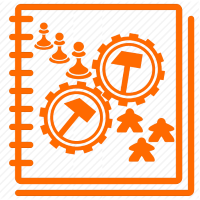Game Makeovers Notebook
Not that I don’t have enough to do in working on several original designs and concepts, but the brain is always looking for creative distractions to “recharge under load” and to break out of neural pathways that rut so quickly. Who knows, maybe this process will result in something worthwhile itself as well.
There is value in deriving something new from something known; those who know the original are on their way toward understanding the new. It is a form of assimilation. Resistance is futile.
One might criticize, “A makeover isn’t original and is a waste of time.” I think that makeovers are not only valuable exercises, but they also result in very viable games. There are many and one might even say that most games are makeovers of previous games since something truly new comes maybe once a year. Here are a few popular makeovers of very simple traditional games:
Cheesonomics: Go Fish
Diamonds: Whist
King of Tokyo: Yahtzee
Oddball Aeronauts: Top Trumps
One Night Ultimate Werewolf: Werewolf/Mafia
Objective
Redesign a traditional game or game system to make a more modern, fun, interesting, probably less random and more interactive game while maintaining enough of the original game that it is still obviously “in there.” In this process I expect to post:
- An evaluation of the existing game/system for what is working and what needs work.
- A description and rationale of each “improvement.”
- The evaluation – redesign – playtest cycle for major changes.
- Any tools that I use or create in the process.
- A description with rules and PnP files (as appropriate) of the “final” product (at least as far as I intend to take it) and a comparison to the original.
- (Maybe) A step or two further; breaking my first rule of trying to maintain a recognizable semblance to the original game and seeing how far I can take the design.
Hopefully you find this discovery process interesting and maybe even gain some inspiration from it.


